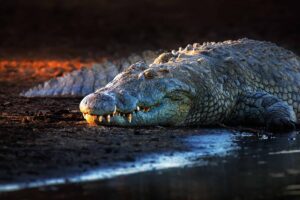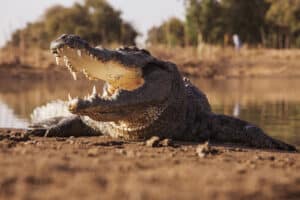The largest crocodile skull in existence is an 84 cm long skull of a Malayan false gharial (Tomistoma schlegelii). Just the head is more than 2 ½ feet long! Can you imagine how long that crocodile is? Skulls give us details about animals from the past. Their teeth give us clues about what they ate and how long they may have lived. Crocodiles have sharp interlocking teeth that are often well preserved in fossilized skulls. Let’s take a look at what makes crocodile skulls so unique.
What Do Reptile Skulls Have In Common?
Reptiles are diapsids, meaning they have two openings in their skull on both sides of the head, just behind the eye socket. These openings are called the upper and lower temporal openings. There are always exceptions in the animal kingdom, so you will find turtles and some extinct groups that are not diapsids. They are considered anapsids with no opening behind the eye socket.
What Are The Two Openings Behind The Eyes In A Crocodile Skull For?
The upper and lower temporal openings give the jaw bone muscles room to expand. Their powerful jaws have the strongest bite force of any animal. Lions and tigers have a bite force of around 1,000 psi (4,450 newtons), but the crocodile has a bite force of 3,700 pounds per square inch! That is the same as 16,460 newtons. Now, that is a powerful bite.
What Is So Unique About Crocodile Skulls?
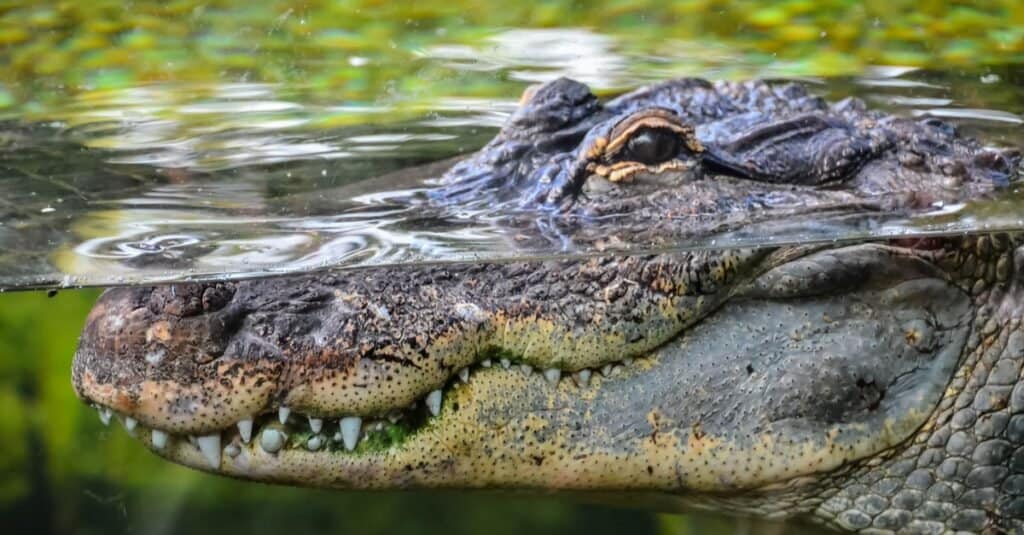
The nostrils on a crocodile are on the top of the snout so they can keep most of their body underwater to hide from unsuspecting prey.
©underworld/Shutterstock.com
One thing that is unique about crocodile skulls is that they have a secondary bony palate that other animals do not have. The palate is the roof of your mouth. Crocodiles have a second one that separates the nasal passage. Their nostrils are on the top of their snout, and they lead to the back of the throat through the nasal passage to the choana (the spot where the air enters the throat). When you learn about the history of ancient crocodiles, you’ll find out the skulls of fossils show that this choana is located further back as crocodiles evolved.
What Is Missing On A Crocodile Skull?
Crocodile skulls do not have an opening for a parietal organ, sometimes called a third eye or pineal eye. Animals with a third eye cannot see with it, but it is used as a sensing organ, thought to trigger hormones, and used in thermoregulation. Lizards like bearded dragons and iguanas have a parietal organ and an opening in their skull where it is located. Crocodiles do not have this.
Are All Crocodile Skulls The Same?
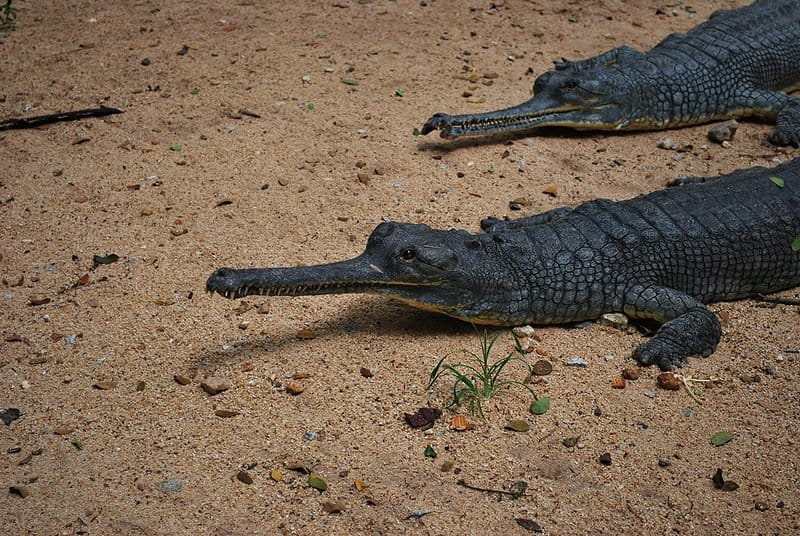
Gharials have skinnier snouts and smaller skulls.
Crocodile skulls are very different. There are 24 different crocodile species (alligators are one of the crocodile species), and each skull is a little different. The biggest difference between an alligator and a crocodile is that an alligator has a rounded, wider snout, and a crocodile has a V-shaped, skinnier snout. Gharials, another crocodile species, have a very long skinny snout (and, therefore, a long skinny skull).
How Many Teeth Do Crocodiles Have?
Crocodiles with longer snouts have more teeth, which makes sense!
- Dwarf crocodile: 60 teeth
- Saltwater crocodile: 66 teeth
- Nile crocodile: 64-68 teeth
- Alligators: 74-80 teeth
- Gharial: 110 teeth
Are Crocodile Teeth Sharp?
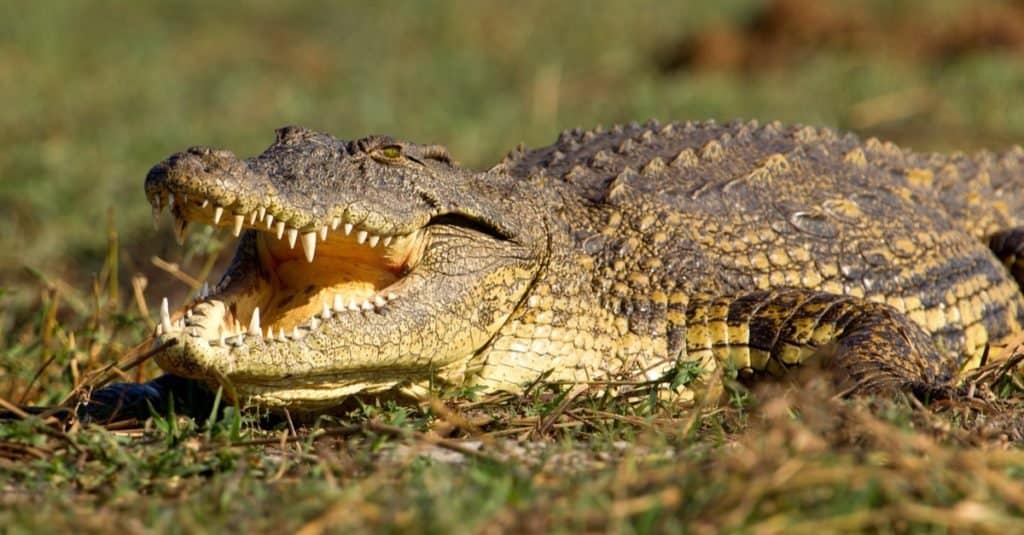
Crocodiles have conical teeth on the top and bottom jaw.
©Gaston Piccinetti/Shutterstock.com
Crocodile teeth are conical and sharp but not as sharp as the fangs of a snake. There is not a sharp point at the tip. They are actually rounded and blunt. You could run your finger along the bottom row of a crocodile skull and not get cut. Crocodiles use their powerful jaws to snap shut on their prey, like wildebeest. They use their teeth to keep the animal in their jaws so that they can drag it into the water and drown it. This is called the “death roll.” Crocodiles do not have any molars for chewing. They swallow their food whole instead.
What Crocodile Has The Largest Teeth?
The Deinosuchus is an ancient crocodile that has the largest teeth. One look at the Deinosuchus skull, and you understand how it got the nickname “terrible crocodile.” Fossils of this crocodile have been found in the USA and Mexico. The largest teeth were eight inches long. Think about that; a dinner knife is 9¼ inches. So, this crocodile had rows of teeth a little smaller than dinner knives! Deinosuchus were some of the largest crocodiles with estimated lengths of 30-40 feet. Big croc, big teeth!
What Is The Largest Crocodile Skull Ever?
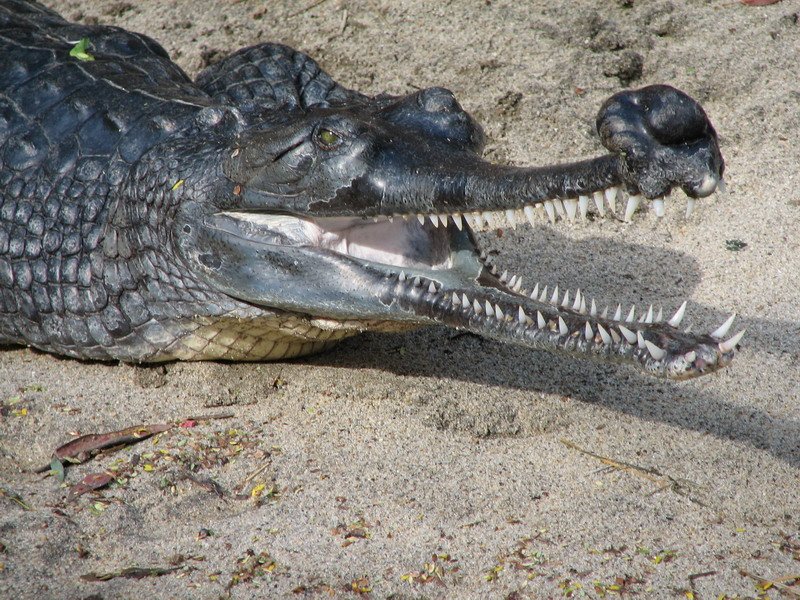
Gharials have the longest, skinniest snouts of all the crocodiles.
©Justin Griffiths / Public Domain, Wikimedia Commons – License
The largest crocodile skull is 86 cm long. It is from a Malayan false gharial (Tomistoma schlegelii). Remember, gharials have the longest skinniest snouts of all the crocodiles. False gharials (sometimes called Tomistomas) are a separate species but look similar to gharials. This skull is on display at the British Museum. Two other noteworthy crocodile skulls are displayed at the Munich Museum, a False Gharial that is 81.5 cm, and one at the American Museum of Natural History, which is 76.5 cm.
What Is The Largest Skull For A Land Animal?
According to the Guinness World Records, the largest skull for a land animal is the Pentaceratops dinosaur, with a skull that is 3.2 meters high (10 ft 6 in). This giant skull is on display at the Sam Noble Oklahoma Museum of Natural History at the University of Oklahoma in Norman, Oklahoma. The Pentaceratops looks similar to a Triceratop with a large bony frill above its head. The fossil skull was found in New Mexico in 1941.
What Animal Has The Largest Skull Ever?
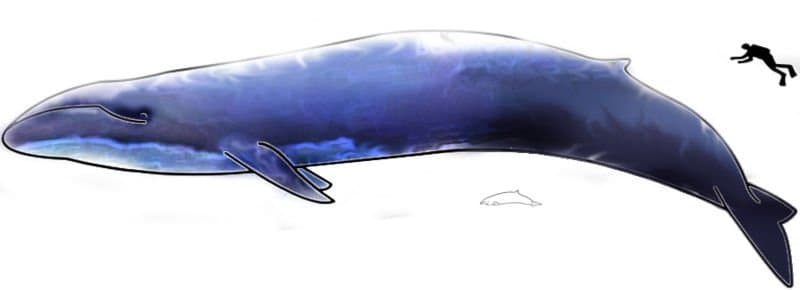
Blue whales have the largest skulls of all animals, including dinosaurs.
©T. Bjornstad (TBjornstad) / Public domain, from Wikimedia Commons, the free media repository – License
The blue whale has the largest skull ever. Blue whales are even bigger than any dinosaur that ever lived. Blue whales can grow to be 100 feet long, but most average 70-80 feet. A complete skeleton of a blue whale is on display at the Natural History Museum in London. You can walk underneath the skeleton of the largest animal in the world. The one on display is 25 meters long (82 feet). The skull is 6 meters long, that is 20 feet!
The photo featured at the top of this post is © Daderot / CC0 1.0 – License / Original
Thank you for reading! Have some feedback for us? Contact the AZ Animals editorial team.




